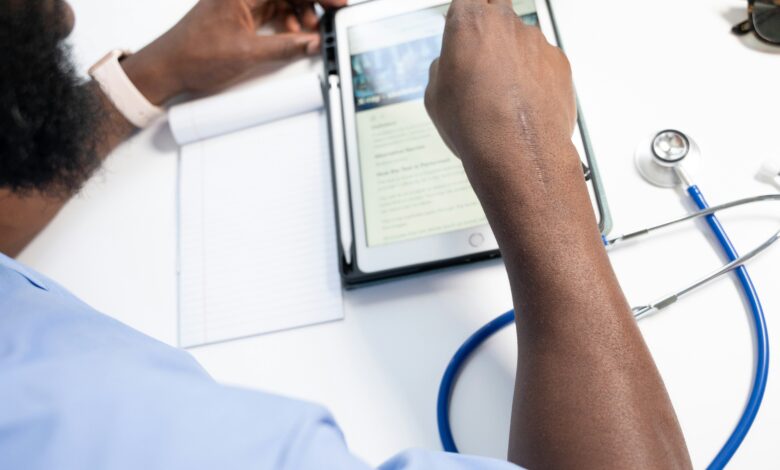
How EMR Improves Patient Care in Medical Facilities
Key Highlights
- EMR (Electronic Medical Records) centralizes patient information, enabling more efficient and personalized care.
- Quick access to patient data streamlines clinical workflows for healthcare providers.
- Enhances communication among medical professionals, ensuring coordinated treatment plans.
- Reduces errors by eliminating manual paper records and integrating advanced coding tools.
- Supports regulatory compliance while improving documentation quality for revenue cycle management.
- Enables seamless integration with lab results, e-prescribing, and other medical tools to deliver better outcomes.
Introduction
The healthcare industry is rapidly evolving with the use of EMR systems in clinics and small practices. These systems centralize records, making them accurate and accessible, leading to better patient care and reduced errors. EMRs boost teamwork, reduce administrative load, and help providers manage their practices smoothly.
🔗 Book a free EMR software demo (USA)
Understanding EMR and Its Impact on Patient Care
EMR stores patient medical data electronically, helping healthcare professionals make faster and better decisions. It improves workflow and allows clinicians to work together by providing real-time access to critical data.
What is EMR, and how does it differ from EHR?
EMRs are used within one practice to store patient histories, lab results, medications, and diagnoses. EHRs go a step further by connecting multiple systems across providers and even across borders.
For example, the best EMR software for small practices might prioritize simple interfaces and specific features, while broader EHR platforms offer cross-network sharing.
What is an EMR, and how does it differ from an EHR?
An EMR, or electronic medical record, is a digital version of a patient’s paper chart used primarily by healthcare providers. It differs from an EHR (electronic health record), which provides a broader view of a patient’s health history and can be shared across multiple facilities for comprehensive care management.
The Role of EMR in Streamlining Clinical Workflows
An EMR software system changes the way healthcare providers work by automating regular tasks and boosting efficiency, including EHR software functionalities. For clinicians, this means they have less administrative work and more time to focus on their patients. Integrated practice management software connects medical data with the needs of operations, making everything run smoothly.
In busy medical places, EMRs make scheduling appointments, handling test results, and processing prescriptions easier by reducing repetitive tasks. With features like customizable templates and task management, EMRs fit nicely into daily routines.
Besides helping improve workflow, EMR systems help healthcare facilities follow complicated rules and coding standards. This not only makes operations inside smooth but also leads to better outcomes for patients. Well-organized data systems prepare them for audits, increasing transparency and reliability in the medical workflow.
Key Benefits of EMR in Enhancing Patient Outcomes
The benefits of EMR systems in healthcare are clear, especially when it comes to improving patient outcomes. EMRs offer easy access to complete patient records. This helps doctors make informed and faster decisions.
Also, EMRs improve communication and teamwork among healthcare providers. This leads to better care coordination. This connected system lowers the chances of medical errors, improves treatment accuracy, and keeps care continuous. With tools like e-prescribing and diagnostic help, EMRs make a big difference, leading to higher patient safety and satisfaction.
Improved Accessibility of Patient Records
With EMR systems, getting medical records is now much easier. Electronic patient data lets healthcare providers find important information right away, no matter where they are. This means that key patient history, test results, and current treatment plans are always close by for clinicians.
This easy accessibility also helps improve patient care. It allows quick decisions during emergencies or tricky diagnoses. Medical professionals no longer have to deal with delays from paper records or scattered storage systems. They can focus on giving accurate and personal care.
On top of that, cloud-based EMR solutions let healthcare providers access medical records securely from any device, making it a robust EHR solution. This is great for practices with multiple locations and specialists because it leads to quicker and more connected care. EMRs are essential for providing accessible and effective healthcare services in medical facilities.
If you’re considering an EMR solution, let us help. 🔗 Book your EMR software demo here
Enhanced Communication Between Healthcare Providers

EMR systems help healthcare providers talk to each other better. This means team members can see patient updates right away. This shared access keeps mistakes from happening because of missing or unclear information.
Better communication leads to:
- Teamwork in making treatment plans for complex cases.
- Quick sharing of lab results, imaging, and prescriptions.
- Easy referrals for seeing specialists.
The support team feature makes it clear who needs to do what, which improves workflow. For patient care, better communication speeds up diagnoses and treatment, even during emergencies.
Communication through EMR systems doesn’t just help how we work inside; it also builds trust between teams, helping everyone work toward better patient outcomes. By making it easier to connect across departments, EMRs improve care coordination in medical facilities.
Integrating EMR into Existing Medical Practices
Introducing EMR systems to medical practices needs a careful plan to make sure they fit in smoothly. For healthcare facilities, using EMR technology helps improve practice management and meet the latest rules.
The change starts by learning what the software can do and matching it with current workflows. It is important to train medical professionals to use the software well. When done right, EMR implementation can change medical practices. It connects new technology with better patient care delivery.
If you’re considering an EMR solution, let us help. 🔗 Book your EMR software demo here
Steps for Successful EMR Implementation
A good EMR implementation strategy needs careful planning and teamwork. Start by looking at what your practice needs. Then, choose an EHR system that fits your goals.
After that, pay attention to important implementation steps like training staff and adjusting the system. Hold training sessions to help clinicians and office staff understand how to use the software’s functionality. This helps make the change smoother. It is also important to align workflow. Make sure EMR processes work well with current patient care models to prevent issues.
Finally, keep an eye on things and evaluate how well it’s working. Use feedback from those using the system to find ways to improve and adjust workflows. Putting thought into how you implement the system helps your team use EMR effectively, improving both patient care and how the operation runs.
Overcoming Common Challenges in EMR Adoption
Adopting EMR systems can bring challenges such as resistance from staff, steep learning curves, and technical barriers. However, proactive measures can address these hurdles.
| Challenge | Solution |
|---|---|
| Resistance to change | Provide comprehensive training and emphasize benefits. |
| Complex system navigation | Choose user-friendly software with intuitive interfaces. |
| Technical breakdowns | Ensure robust customer service support. |
Healthcare providers can mitigate these challenges by partnering with vendors offering flexible onboarding support. An EHR system with scalable options ensures adaptability for various medical environments. Moreover, reliable customer service fosters smoother adoption, enabling healthcare teams to concentrate on their core mission: patient care.
Conclusion
In conclusion, using Electronic Medical Records (EMR) is not just about adding technology. It changes how we care for patients, making medical practices more efficient and effective. EMR helps to streamline workflows and improves communication among healthcare providers. This greatly improves patient outcomes. Having better access to medical records allows for quicker interventions, which is very important. As medical facilities add EMR systems, they must focus on good implementation and tackle any challenges. The path to better patient care starts with understanding EMR. This move creates a healthier future for patients and providers. If you are thinking about adding EMR to your practice, now is the time to take action and make a difference.
If you’re considering an EMR solution, let us help. 🔗 Book your EMR software demo here
